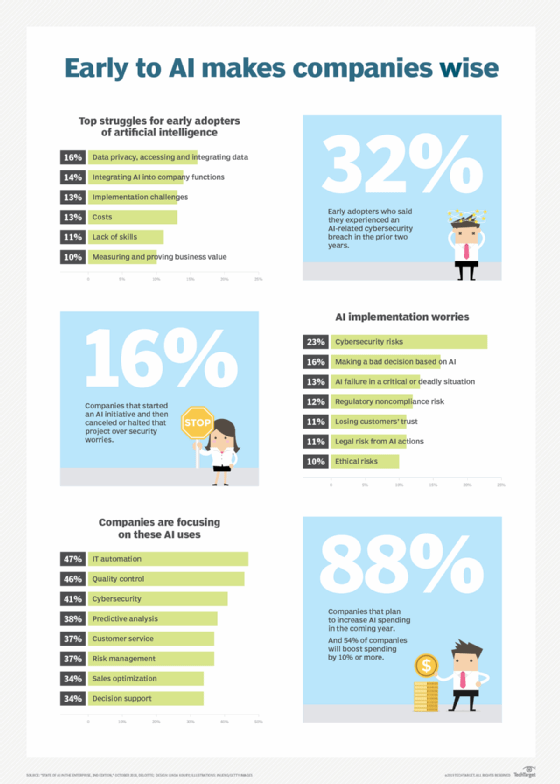
AI as a service democratizes benefits of new tech tools
The emergence of AI-as-a-service tools is helping more enterprises access the benefits of AI, not just the leading-edge tech companies that pioneered the technology.
For First Horizon National Corp., one of the largest regional banks in the southeastern United States, with more than 250 branches and about 6,000 employees, it used to take three months to run internal employee surveys and produce reports for managers.
"That's a lot of time and money," said Mario Brown, the vice president who heads up talent strategy and development at the bank, based in Memphis, Tenn.
First Horizon was already using a cloud-based human resources management platform from Ultimate Software. But two years ago, it started using a new AI-as-a-service tool from the software company called UltiPro Perception that allowed it to survey its employees and then analyze their responses to open-ended questions,
Today, the process is almost instantaneous, and managers are able to get important and immediate information about what employees are happy or dissatisfied about, as well as advice about what to do next.
"We feel that this is really making a positive improvement in the organization," Brown said.
Brown and his team were able to accomplish this without resorting to high-priced data scientists and AI developers because of the growing trend of AI as a service.
AI as a service helps spread benefits of AI broadly
According to the latest predictions from McKinsey & Co., artificial intelligence will generate $13 trillion in new global economic activity by 2030 and increase gross domestic product (GDP) growth by an addition 1.2% a year.
That's more than the steam engine's 0.3% GDP boost, or the 0.6% annual impact internet had in the first decade of this millennium.
As with the earlier technological revolutions, however, the benefits won't be distributed uniformly.
Specifically, not every company will have enough data scientists to create AI algorithms or enough data to train those new AI systems.
In addition, companies will need to build software infrastructure to make use of the insights generated by AI, address implementation challenges and figure out how to integrate the new tools into their business processes.
Those might seem insurmountable problems for any company that's not Google or Facebook.
"It is becoming clear that do-it-yourself will not work," said Svetlana Sicular, an analyst at Gartner who specializes in artificial intelligence. "It's hard to find skills -- and attrition is also high, because everyone is hunting them."
But, in fact, through the rise of AI as a service, even the smallest firms are already starting to reap the benefits of artificial intelligence.
AI as a platform grows up
The most fundamental type of AI technology available online is AI as a platform.
For those companies that don't have the data scientists on staff to create their own neural networks and write their own algorithms for advanced analytics, a number of tools are becoming available from the leading vendors.
IBM, Microsoft, Amazon and Google all offer AI development platforms to help companies with some of the most difficult aspects of AI and machine learning.
Even specialized AI hardware is available on demand via the cloud, such as Amazon's. Google has made available its TPUs, or Tensor Processing Units, for Google Cloud customers who want to make their AI applications more powerful.
Amazon is not far behind. It plans to roll out its AWS Inferentia platform later this year, designed to reduce costs and processing times for its cloud computing customers.
China's Alibaba also announced that it will release an AI chip this year, AliNPU, which is custom designed for AI tasks, such as image and video analysis. The new chip will support the company's plans to expand its cloud business.
These platforms are designed to make it easier for companies to deploy AI technologies by eliminating the need to build the basic infrastructure from scratch.
But there are even easier options.

Ready-to-go AI tools
If a company is looking to build basic AI functionality into one of its own applications, it first needs to pause and check whether someone has already done the work for them.
Chatbots, language translators, image processors and many other functions are now available, ready to be embedded into existing code via APIs.
Some of these tools are very basic. For example, Google has long provided a custom search engine that developers can embed into their own websites.
The system uses Google's own search platform as a back end and uses all the intelligence that Google is adding to its search product on a daily basis.
Amazon Lex is a service for building Alexa-style conversational interfaces into any application using voice and text. Boston-based insurance giant Liberty Mutual Group, for example, used Amazon Lex to create a virtual assistant for its 50,000 employees.
In fact, a number of vendors have sprung up recently offering chatbots and similar AI-powered tools for enterprise developers.
"You don't have enough data scientists because it's an occupation that requires a certain background and certain inclinations," Gartner's Sicular said. "But there are many, many more developers who are available."
But what about companies who don't have even that?
That's where one of the most powerful types of AI as a service is making a big impact.
Embedded AI
More and more major vendors of enterprise cloud applications are embedding AI technology into their existing services or offering it as a premium add-on.
That includes Microsoft Dynamics and Office 365, Salesforce Einstein, SAP and many other major enterprise software vendors, Gartner's Sicular said.
The cloud software vendors already have access to massive amounts of training data to power these systems, while individual companies typically only have access to their own internal data, which can give their offerings an advantage over what an individual enterprise might be able to do on its own.
Embedded AI can be almost invisible to end users. It will just look like the cloud services got smarter or easier to use, or new functionality is available that wasn't there before.
For example, there are many users who don't know how to use analytics tools or query databases.
"But when something is readily available as a dashboard, with the analytics on the back end driven by AI, the adoption is very high," said Vivek Katyal, global leader for analytics and data risk at Deloitte Risk and Financial Advisory. "But the migration is there; those tools are available," he said.








